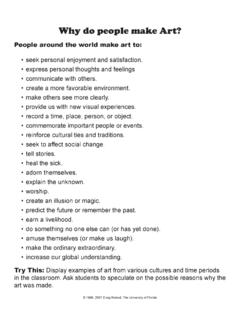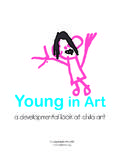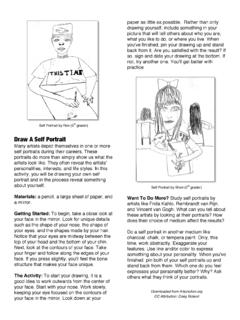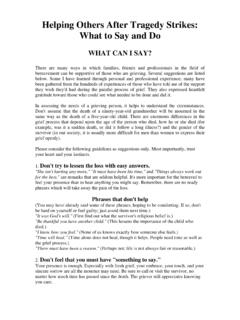Transcription of Some BIG QUEStions in Art
1 Where do artists get their ideas? What can I make art about? When is it okay to copy? Do you have to be able to draw well to be a good artist? What makes some works of art better than others? How can you tell good art frombad art? Is there really such a thing? What work of art do I hate/love the most and why? Why do artists do what they do? How does an artist know when a work or art is finished? What is art? What isn t art? What is art for? Can anyone make art? Can animals make art? Should art be pleasing to the eye? Can art be ugly? Why would an artist make an uglywork of art? Should art make people happy? Should art tell a story?
2 Should artists imitate what they see? In what ways does art represent the world? Does something have to be original to be art? Can a forgery or copy be art? What s the difference between art and craft? What is an artist? Are artists the same in every culture? What are some different ways to approach art? What can we learn from studying awork of art?SomeBIG QUES tionsin Art16 Why do people make Art?Try This: Display examples of art from various cultures and time periodsin the classroom. Ask students to speculate on the possible reasons whythe art was around the world make art to: seek personal enjoyment and satisfaction.
3 Express personal thoughts and feelings communicate with others. create a more favorable environment. make others see more clearly. provide us with new visual experiences. record a time, place, person, or object. commemorate important people or events. reinforce cultural ties and traditions. seek to affect social change. tell stories. heal the sick. adorn themselves. explain the unknown. worship. create an illusion or magic. predict the future or remember the past. earn a livelihood. do something no one else can (or has yet done). amuse themselves (or make us laugh). make the ordinary extraordinary. increase our global mask represents The Cannibal of theMountains and was used in a secret winterceremonial, British Columbia, around is like a border of flowers alongthe course of civilization.
4 Lincoln Steffens17 Why do artists do that?The following list of purposes for which a work of art might have beencreated may prove helpful in sorting through the variety of art formswe see today. A single work of art can serve more than one create to: record images inspired by observations of daily life; connect us with everydayexperience, people or events. demonstrate technical virtuosity; do something no one else can. celebrate the aesthetic qualities of common objects; transform the mundaneinto an object of art; make the familiar strange, the ordinary extraordinary. celebrate beauty as found in the aesthetic qualities of nature; record a timeor place.
5 Explore art that speaks about the basic elements of art; celebrate the aestheticqualities of line, shape, color, and so on. convey dynamics of movement; explore relationships between time andspace. stimulate public discourse; provide social commentary; make peoplethink. emphasize the experience of looking at a work of art. convey a feeling of human emotion; show human experience. explore narrow and personal visions. innovate; give up the old, break the rules; explore new approaches; provideus with new visual experiences. explore new materials and technologies to create new forms of art. express private, personal musings; explore the unconscious.
6 Subvert, create irony; break established notions of how things should be;change people's minds. emphasize the importance of the idea rather than the object/product as thework of art. create optical effects; optics created by shadows and reflection of light. raise QUEStions about art traditions such as, "What is art?" "What is a painting?" commemorate important people or events; reinforce cultural ties andtraditions; tell stories. This: Display examples of art by various contemporary artists. Ask students tospeculate on the possible reasons why the art was be an artist today is to becontinually engaged in questioningwhat art is and what it could be; itis to be constantly reinventing art.
7 George Szekely18 press release : CHRISTO AND JEANNE-CLAUDE: RUNNING FENCE,SONOMA AND MARIN COUNTIES, Fence, meters (eighteen feet) high, 40 kilometers (twenty-four and half miles) long, extendingEast-West near Freeway 101, north of San Francisco, on the private properties of fifty-nine ranchers,following rolling hills and dropping down to the Pacific Ocean at Bodega Bay, was completed on September10, art project consisted of: forty-two months of collaborative efforts, the ranchers' participation, eighteenpublic hearings, three sessions at the Superior Courts of California, the drafting of a four-hundred and fiftypage Environmental Impact Report and the temporary use of hills, the sky and the expenses for the temporary work of art were paid by Christo and Jeanne-Claude through the sale ofstudies, preparatory drawings and collages, scale models and original Fence was made of 200,000 square meters (2,222,222 square feet) of heavy woven white nylonfabric, hung from a steel cable strung between 2,050 steel poles (each.)
8 Meters / 21 feet long, 9centimeters / 3 1/2 inches in diameter) embedded 1 meter (3 feet) into the ground, using no concrete andbraced laterally with guy wires (145 kilometers (90 miles) of steel cable) and 14,000 earth anchors. Thetop and bottom edges of the 2050 fabric panels were secured to the upper and lower cables by 350,000hooks. All parts of Running Fence's structure were designed for complete removal and no visible evidenceof Running Fence remains on the hills of Sonoma and Marin Counties. As it had been agreed with theranchers and with the County, State and Federal Agencies, the removal of Running Fence started fourteendays after its completion and all materials were given to the ranchers.
9 Running Fence crossed fourteenroads and the town of Valley Ford, leaving passage for cars, cattle and wildlife, and was designed to beviewed by following 65 kilometers (forty miles) of public roads, in Sonoma and Marin to consider: (1) Should art be permanent? (2) Must art be made by the artist? (3) Whereshould art by displayed? (4) How big can art get? (5) What can art be made of? (6) Is Running FenceArt?Photo: AK CiesielskiRunning Fence19An Overview of Bloom's Taxonomy ofEducation Objectives: Cognitive DomainOne of the more popular models used to promote thinking skill instruction in schools was developed by BenjaminBloom (1956).
10 It categorizes thinking skills from the concrete to the abstract and in six categories--knowledge,comprehension, application, analysis, synthesis, evaluation. The last three are considered by many educators asinvolving higher-order thinking -- the remembering of previously learned material. This may involve the recall of a wide range ofmaterial, from specific facts to complete theories, but all that is required is the bringing to mind of the appropriateinformation. Sample cue words include: acquire, choose, cluster, define, describe (from memory), draw, fill-in,follow directions, identify, indicate, know, label, list, locate, match, memorize, name, outline (format given), pick,point, read, recall, recognize, record, repeat, reproduce, select, state, sort, -- the ability to grasp the meaning of material.







